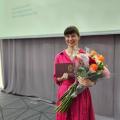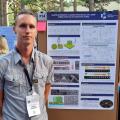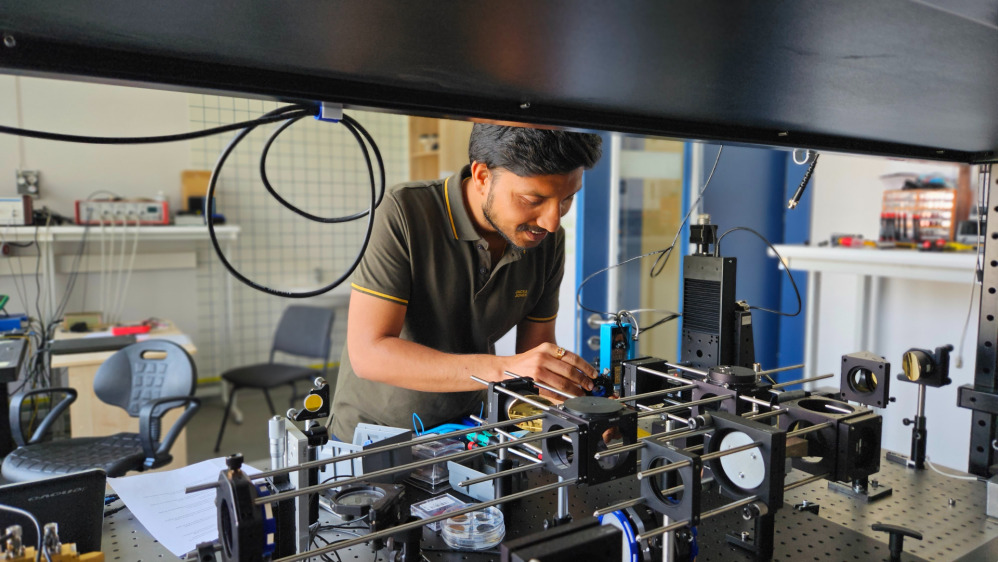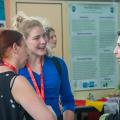- Home
- Nekoreguojami
- Search
Search
2023. 06. 12
-
A new tool to control light: FTMC talent from India has developed a promising hybrid lens
Surya Revanth Ayyagari was born in India. After studying mechanical engineering, he defended his bachelor thesis on nanoparticles in optics. After receiving a lot of appreciation, he decided to go abroad and wrote his Master's thesis in optics and photonics in Germany. In 2021, he joined FTMC as a PhD student in the Department of Optoelectronics.
Surya, who dreams of becoming a researcher, is not alone here: his wife Tripura Ganti, a PhD student, also works at FTMC, in the Department of Catalysis. The conditions for learning and development are excellent, he says. The Lithuanian weather is nice for him too. "Currently, in summer..." - smiles, thanking his colleagues for all their help.
The help is mutual - the talented scientist is involved in the development and improvement of next-generation hybrid lenses, and his paper on so-called hybrid Fresnel lenses was recently published in the high-level international scientific journal IEEE Xplore. The other two authors of the paper are Dr. Simonas Indrišiūnas from the Department Laser Technologies and Dr. Irmantas Kašalynas, a scientist from the Department of Optoelectronics and the supervisor of Surya's PhD thesis.
Fresnel lenses are named after the French physicist Augustin Fresnel. In the 1820s, he invented a new type of lens, which he installed in the Corduan lighthouse. From then on, a single lantern could light the way for sailors many miles out to sea. That's why BBC journalist Adrienne Bernhard called it "the invention that saved a million ships" for good reason.
The lens produced in FTMC laboratories at the time has a different purpose - but, you never know, perhaps just as important.

(Surya Revanth Ayyagari. Photo: FTMC)
What happens in glasses
"The main object of my paper is how to replace refractive optics with diffractive ones," says Surya.
Didn't get anything? No problem, here's the explanation.
Both refraction and diffraction are related to the change of light waves. We all know that light is a wave - and our visible light is just one "kind" of light. If there were no light waves, we would simply not see anything.
Refraction happens when light changes direction, refracts or bends, as it passes from one material to another. For example, light waves traveling through the air are refracted when they hit water. As a result, we see things that are immersed in water slightly differently than they are: e.g. a straw or a pen in a glass of water may look bent.

(A pen partially submerged in a bowl of water appears bent due to refraction at the water surface. Photo: Wikipedia.org)
Refraction can even be life-threatening for non-swimmers! The refraction of a wave gives our eyes the impression that the bottom of the lake is much closer than it looks. If we believe this, we may be very unpleasantly surprised when we jump off a pier.
Meanwhile diffraction happens when a wave of light hits an obstacle - and causes the light to bend, to narrow, to broaden or to "behave" in even stranger ways. If the refraction of a wave shows a straw in a glass bent, diffraction would cause the straw in the water to face the other way!
As we wrote in our article on metalenses, we can find examples of diffraction in everyday life: if you still know what CDs and DVDs are, you will remember how they shine like a rainbow. This is because of the tiny grooves on the surface of the disc, which become a barrier to light, causing it to change and become so coloured.

(Examples of diffraction. Screenshot from YouTube channel Science Ready)

(Compact disc (CD). Photo: Luis Fernández García / Wikimedia Commons)
Now take off your glasses for a moment (if you don't have them, take them off a colleague's, if asked politely beforehand) - what you are holding in your hand is a refractive optic. Glasses, magnifying glasses, telescopes, microscopes, binoculars - they all have lenses that refract light for our convenience.
That is good. But according to Surya, a PhD student at FTMC, it is not enough for better technology.
That's why the focus is on developing a different kind of optics - one that is called diffractive.
What happens in the labs
The Department of Optoelectronics at FTMC is conducting experiments on one of the "types" of light that is non-visible to the naked eye - terahertz waves. We have written several times about the practical benefits of such research, but it can be recalled that the Center's scientists have been developing terahertz diffractive optics since 2012. They are leaders in this field in Lithuania and are also highly evaluated worldwide.
Thus, S. Revanth Ayyagari is interested in hybrid lenses, which are an integral part of such research. The smaller, thinner the tools that are developed, the better the quality of the research.
"Diffractive optics are similar to what we are used to, but here we are talking about much smaller, nano or micro, scales. Such lenses can be put on chips and are more efficient than refractive optics.
In my paper, I also describe novelty in the fabrication of diffractive lenses, which is becoming much easier compared to conventional lenses," he says.
One of the goals of researchers around the world is to see diffractive optics used in smartphones. For now, we have conventional, refractive lenses. But the young scientist from India says the new technology will be useful anywhere, in any optical or electronic system:
"For example, if you want to build laser in order to focus some light on the surface, we need diffractive optics because it is better because of a small size.
The geometry is approximately vawelenght of light emitted by the laser and is tens and hunderts or thousands times smaller than refractive optics."

(Hybrid diffractive lens. Photo: FTMC)
What did Surya achieve? He made thin diffractive lenses from silicon, up to a few hundred micrometres thick, for use in terahertz experiments. A micrometer is one thousandth of a millimetre.
"But these lenses can be scalable for any frequences. It can be useful for visible or infrared light, microwaves, terahartz. It depends on wavelenght and the thickness of the lens. We made our lenses out of silicon because it is a quite transparent material with less losses," says the physicist.
The lenses are created by laser ablation, which involves "cutting" or otherwise removing a material from a solid or liquid using fast laser pulses.
In his paper, an Indian PhD student from FTMC describes a key problem in this field which is time: "If you want to fabricate the component it takes days and weeks and waste of money as well. So my main focus is to reduce the time and achieve higher efficiency."
Another goal was to reduce the number of diffractive optical elements (DOEs) in a pattern of the hybrid lens. Such pattern ir the one that is laser-printed on a silicon wafer and gives the lens the properties it needs. The so-called diffractive lens pattern is made up of different sized particles (like the pieces of a jigsaw puzzle).
Such pieces are large in the centre of the lens and therefore easy to produce. Unfortunately, as you move away from the centre, the size of the elements in the pattern decreases exponentially to such a small size that it is difficult to 'draw' them with a laser beam. Imagine a child’s drawing of a sun with its rays: the first ones will be long, the next shorter, and after a few steps they will become hardly visible dots.
Such obstacles have made it impossible to produce diffractive optics with larger diameters. So the researchers had to take new measures.

(Hybrid diffractive lens. Photo: FTMC)
Surya and his colleagues came up with the idea of a mixed (hybrid) patterning. At the edges of that pattern, tiny elements were replaced by twice as large ones - and according to a specific algorithm. A universal "recipe" has finally been found, with an algorithm that allows hybrid diffractive lenses to be made for any frequency.
This problem has been solved. But what about the fabrication time? Lens tests used to take between one and twenty hours, depending on the dimensions of the lens and how detailed the pattern has to be on the silicon wafer (from which the lens is made). FTMC PhD student managed to reduce the production time by a factor of about four, moreover, the hybrid lens proved to be as efficient (even ten percent more efficient!) compared to a conventional diffractive lens.
According to the scientist, it is still too early to predict when this technology will reach our everyday devices - diffractive terahertz optics is still a new field for business. But when it comes to research in laboratories, it is not new - and Surya is one of those who, together with his colleagues, is trying to complete everyone's expectations.
Joint team from different countries
The talent from India is one of fifteen PhD students participating in the Marie Sklodowska-Curie European Programme, funded by the European Union. This programme is developed by FTMC in partnership with research institutions and businesses from Germany, Spain, France and the United Kingdom.
There are fifteen such international partners in total and they are united in the European training network TERAOPTICS. These institutions are also advised by non-core partners, not only from European countries, but also from the USA and Japan.
As a TERAOPTICS project promoter, FTMC had the opportunity to invite Surya to study for a PhD under the Marie Sklodowska-Curie programme.
"This is informal training for young researchers - they have to be given the conditions to do a PhD, although they do not have to be 'real' PhD students. They follow a university programme, but with more practical tasks. The third thing is that it is not only universities that participate in this network, but also companies," says Dr. Irmantas Kašalynas, a supervisor of Surya PhD Programme and Chief Scientist of the Department of Optoelectronics at FTMC.
He himself had the opportunity to benefit from the Marie Sklodowska-Curie network, having travelled to Delft University of Technology in the Netherlands for a postdoctoral fellowship in 2005 under a similar project.

(Dr. Irmantas Kašalynas. Photo: Remigijus Juškėnas / FTMC)
"I know the benefits of such projects inside out. The networking and professional contacts last for a long time. I still keep in touch with former colleagues. So I want to pass on to younger colleagues that it can help shape their academic future and their scientific career. It's not immediately apparent, but in ten years' time it will be."
In the meantime, the training of fifteen PhD students is the first such project to be carried out at the Terahertz photonics laboratory. While S. Revanth Ayyagari is mentored by FTMC, he also travels to other partners in the network - universities and private companies - for internships of one to one and a half months. The aim is for the young person to gain the practical knowledge and experience that will be the much needed "salt" for his/her career.
"I think it is a prestige and an international recognition of FTMC that we are able to train such PhD students. That we are in this network, that we are visible.
We are also valued because we receive EU funding - there are more similar research networks in Europe and the chance of one being funded is only 5%. There is a lot of competition", says Kašalynas.
Written by Simonas Bendžius
Related news:

2024. 09. 24
-
J. Jorudas defends his PhD thesis on materials for telecommunication sensors
He studied the physical properties of gallium nitride structures and graphene.

2023. 09. 08
-
S. Pūkienė, a physicist who develops sensors, becomes a PhD in Technological Sciences
How can gallium arsenide bismide serve science and society?

2023. 08. 30
-
FTMC poster presentations - the best at the Conference for the young scientists
Among the winners were 4 of our researchers - Kernius Vilkevičius, Aivaras Špokas, Kasparas Stanaitis and Jorūnas Dobilas.

